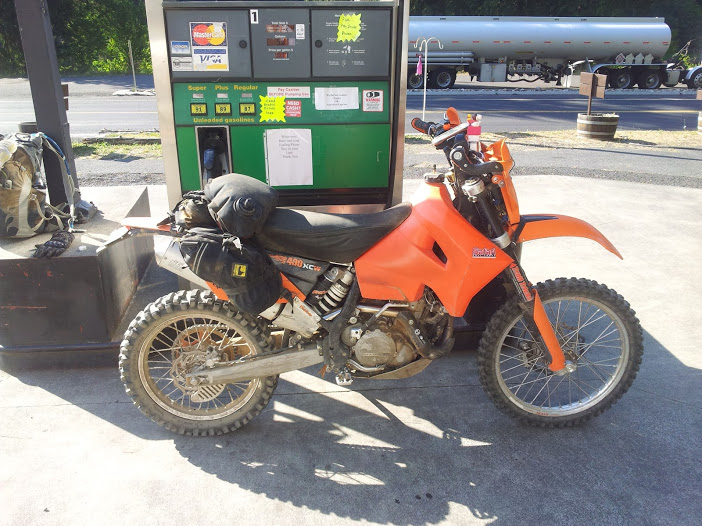General Trek Bike Setup Tips:
You will need gas capacity to go 150 miles plus spare for GRIT1 and GRIT2 in self support mode. Everyone starts with a large tank, but many also use supplemental gas containers like the Giant Loop Gas Bladder or the MSR Dromedary Bladder. The Dromedary is not rated for gas, but well tested. There are also more creative ways like a cargo rack and strap on gas cans. Do your own gas mileage testing on trails to determine how many gallons you will need.
You will need good lights. The latest LED lights are light, powerful and low wattage. The full HID Baja lights are powerful too, but heavier, and often require stator upgrades. A good HID compromise is the Trailtech X2 but this still drives many bikes to a new stator. An LED or HID helmet light adds complication, but is a nice asset when going faster at night to see over that hump or around that corner or even to read that sign you just passed. At a minimum, a decent economy upgrade is one of the new LED headlight bulbs. A stock 35 watt incandescent headlight will frustrate you when you are searching your way for hours into the night.
Air filters can be cleaned, but filter skins are a much easier way to maintain it along the trail and just pack up the old one in a Ziploc and install new ones.
Some run the same synthetic engine oil the entire route, but some change it half way through. Either way, check it every day and run good quality oil and carry a some spare.
Hardened steel sprocket teeth and a strong x-ring chain are the best way to minimize adjustments and chain breakage risk. The web links here are a combination that has gone the length of Idaho 3 times with more life left (your throttle wrist may vary).
You can use heavy duty, or Bridgestone ultra heavy duty inner tubes with Slime and check the air pressure every day to minimize flats. But a bib mousse tube has also been successfully used to avoid the need for flat repair kit and spare tubes in your cargo.
Tune your suspension for endurance/comfort. No double jumps here (unless you see “kelly humps” different than I do). Fresh suspension oil, especially fork oil goes a long way.
For tires, most any high quality front knobby will work well. But not so many rear tires can make it to the end of a GRIT1 run. The two most popular tires that have been proven to go the distance are the AT81RC or the MT43 trials. Others have made it too, but these two make it with ease.
You also need cargo luggage, GPS with mount, bike guards, reliable engine cooling, comfortable seat, plus fresh wheel bearings and grips. Your body will benefit from a steering damper and auto-clutch too. A full maintenance check list can be found here: Neduro’s Spring Bike Maintenance and Setup Guide.
Bike Licensing
You will need a legal license plate to ride the street and even forest roads of Idaho. At a minimum, you can ride with the Idaho restricted plate, which means you can ride anywhere other than highways or freeways as long as you carry liability insurance, brake light, headlight, horn, and mirror. There are a few miles of state highway along these treks, so you are taking a bit of a chance still. It’s not uncommon to see ATV’s out on pretty much any country road here, but we’ve seen people checked too. Idaho code 67-7124 provides for non-residents to get an ID restricted plate. Here’s more information: OHV Laws, Rules and Requirements_2011.pdf


Recent Comments